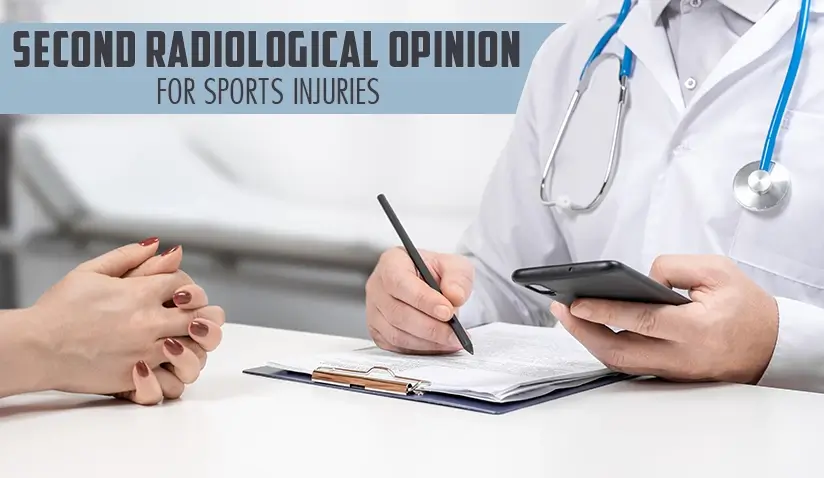Second Radiological Opinion for Sports Injuries

An accurate diagnosis and optimal treatment plan are paramount for athletes recovering from injuries. Whether amateur or professional, athletes have a lot at stake when it comes to injury recovery. A swift and thorough recovery from injuries is crucial for their ability to perform and achieve their goals. Seeking a second radiological opinion can be a vital step in this process. While team physicians and local doctors play a crucial role in initial diagnosis and treatment, consulting with an orthopedic or sports radiology specialist can provide valuable insights, ensuring the most precise diagnosis and effective recovery strategy.
Musculoskeletal injuries can be complex, and an accurate diagnosis is crucial for optimal treatment outcomes. These injuries may require specialized knowledge and advanced imaging techniques to identify subtle but critical details, which is why a second opinion from an orthopedic or sports radiologist can be valuable.
What’s Involved in Obtaining a Second Radiological Opinion for Sports Injuries?
A second radiological opinion involves seeking an additional interpretation of radiological images (such as X-rays, MRIs, or CT scans) from a specialized radiologist, particularly after an initial diagnosis of a sports injury.
This process ensures that the imaging results are thoroughly reviewed by a second expert who can provide an independent assessment. The objective is to either confirm the initial diagnosis or offer new insights that could lead to a more accurate understanding of the injury and, consequently, a more effective treatment plan.
The Role of a Musculoskeletal Radiologist
Musculoskeletal (MSK) radiology is a subspecialty within radiology that focuses on interpreting imaging studies of the bones, joints, and soft tissues. MSK radiologists possess specialized training and advanced knowledge in this area, allowing them to identify subtle abnormalities that might be missed by general radiologists or other physicians. This expertise is particularly valuable in diagnosing sports injuries, where precise diagnosis is crucial for treatment and recovery.
MSK radiologists undergo extensive training to recognize the specific characteristics of a wide range of musculoskeletal conditions. Their ability to differentiate between similar injuries and identify less obvious issues provides important information for healthcare providers when determining the course of treatment.
Collaboration between MSK radiologists and other specialists, such as orthopedic surgeons, sports medicine physicians, rheumatologists, and physiotherapists, is vital for ensuring comprehensive patient care. These specialists may request an MSK radiologist's interpretation for a variety of reasons, such as confirming a diagnosis, evaluating the extent of an injury, or understanding the full impact of a condition.
When and Why is a Second Radiological Opinion Indicated?
Why is it indicated?
A second radiological opinion is often indicated to ensure the accuracy of a sports injury diagnosis and to develop the most effective treatment plan. Misdiagnosis can lead to delayed recovery, inappropriate treatments, and potential complications.
Common errors in radiological reporting that can significantly impact an athlete's health and career include, but are not limited to:
- Overlooking small fractures
- Misinterpreting ligament injuries
- Misinterpreting muscle injuries
- Failure to appreciate cartilage injuries
Research indicates that such errors can arise from various factors, including the radiologist's experience level, knowledge of the sport and clinical context, and the complexity of the injury.
When is it indicated?
Before a Major Procedure or Complex Injury
- Complex Ligament Tears: These injuries, for example, ACL injuries in the knee, require precise imaging interpretation to determine the extent of the damage and associated injuries to plan surgical or rehabilitative interventions.
- Stress Fractures: Small, hairline fractures, common in weight-bearing bones, can be difficult to detect but crucial to diagnose accurately to prevent worsening.
- Suspected Bone Marrow Edema: This condition is a reaction within the bone and can indicate stress injuries or early-stage conditions that require timely intervention.
- Muscle injuries: Detailed assessment of the exact severity and extent of the injury helps determine the time to return to play (RTP)
In Case of Concerns About the Treatment Plan
- Athletes or their healthcare providers may seek a second opinion if there are doubts about the recommended treatment's effectiveness or safety.
When Doubts Persist or to Interpret Inconclusive/Ambiguous Reports
- Initial imaging reports may sometimes be inconclusive or ambiguous. Discrepancies in initial readings can arise due to varying expertise levels or subtle image findings. Expert insights from radiologists specialized in sports and musculoskeletal imaging can clarify these uncertainties.
When Symptoms Persist After a Procedure or Course of Treatment
- If an athlete continues to experience symptoms despite following a prescribed treatment plan, a second opinion can help identify any missed issues or complications that might be causing ongoing problems.
Scenarios Where a Second Opinion is Crucial
- Young Athletes: Early and accurate diagnosis is critical to prevent long-term damage and ensure healthy development.
- Potential Career-Ending Injuries: When the stakes are high, and an athlete's career is on the line, ensuring the accuracy of the diagnosis and treatment plan is paramount.
Case Studies Highlighting the Importance of Consulting a Specialist in Musculoskeletal Imaging and Sports Radiology
Case Study 1: The Role of MRI Scan in Sports-Related Anterior Cruciate Ligament (ACL) Injuries
A recent study published in the Journal of Clinical Orthopedics and Trauma discussed the efficacy of MRI in diagnosing sports-related ACL injuries. This review highlighted a case where an initial diagnosis based on a standard clinical examination suggested a minor knee sprain.
However, the athlete continued to experience significant knee instability. An MRI scan, interpreted by a musculoskeletal radiologist, revealed a complete ACL tear that was missed during the initial examination. This accurate diagnosis allowed for timely surgical intervention, which ultimately prevented further knee damage and facilitated a successful recovery.
Case Study 2: An Uncommon Case of Right-Hand Pain in a Professional Hockey Player
A professional hockey player presented with persistent right-hand pain that was initially diagnosed as a simple strain. Despite standard treatment, the pain persisted, affecting the player's performance.
A second opinion was sought from a sports radiologist, who identified a rare type of stress fracture in the carpal bones through advanced imaging techniques. This precise diagnosis led to a targeted treatment plan involving immobilization and physical therapy, allowing the player to return to the sport pain-free and avoid potential complications.
Case Study 3: Diagnosing a Rotator Cuff Tear with MRI
A middle-aged athlete experienced shoulder pain and weakness after a fall, with an initial diagnosis suggesting a minor muscle strain. However, the pain persisted, prompting a second opinion from an MSK radiologist.
The MRI interpretation revealed a partial-thickness rotator cuff tear, which had been overlooked initially. This accurate diagnosis enabled the athlete to undergo appropriate treatment, including physical therapy and minimally invasive surgery, resulting in a full recovery and return to normal activities.
Case Study 4: Soccer Player - Hip Labral Tear Second Opinion
A young soccer player underwent hip surgery for a labral tear but continued to experience post-surgery pain and limited mobility. Concerned about the persistent symptoms, the athlete sought a second opinion from a musculoskeletal radiologist.
The second MRI scan revealed incomplete healing and additional damage to the hip joint. This crucial information led to a revised treatment plan involving further surgery and specialized rehabilitation, which significantly improved the athlete's condition and performance.
Case Study 5: Misdiagnosis of a Complete ACL tear in an Amateur Runner
An amateur runner suffered a knee injury during a marathon, with initial imaging suggesting a minor ligament sprain. The athlete's continued instability and pain led to a second opinion from an MSK radiologist.
The subsequent MRI revealed a complete ACL tear and associated meniscus damage that was missed initially. This comprehensive diagnosis allowed for a personalized surgical and rehabilitation plan, ensuring the runner's successful return to competitive running.
Benefits of a Second Radiological Opinion
- Improved Diagnostic Accuracy: A second opinion enhances the accuracy of diagnosing sports injuries by providing a detailed and nuanced interpretation of imaging studies, ensuring the root cause is correctly identified.
- Enhanced Treatment Planning: Accurate diagnosis leads to more effective treatment plans, thereby optimizing recovery. Identifying issues early allows for timely interventions, reducing complications.
- New Perspectives: A second opinion can highlight alternative treatment options or the need for additional tests, ensuring all possibilities are explored for the best outcome.
- Increased Confidence and Satisfaction: Confirming or refining the initial diagnosis boosts confidence in the chosen treatment approach, improving patient satisfaction and overall recovery.
Factors to Consider When Identifying a Sports Medicine Specialized Radiologist/Facility
Technology
When selecting a radiologist or facility for sports injuries, the technology used is a crucial factor. Different imaging modalities can identify various issues:
- Ultrasound: Ideal for evaluating certain soft tissue injuries such as those involving the Achilles tendon, rotator cuff tendons, and peroneal tendons.
- MRI (Magnetic Resonance Imaging): When the expert needs detailed views of soft tissues, such as ligaments, muscles, or cartilage, MRI is the go-to choice.
- CT Scan (Computed Tomography): Useful for assessing complex fractures and bone structures.
- X-Ray: Primarily used for the initial diagnosis of fractures and dislocations.
3 Tesla MRI, high-resolution ultrasound with high-frequency stick probes, computed tomography (CT), and robotic X-ray systems (such as Multitom) are some examples of advanced technologies that specialized centers might offer. Such innovative solutions enable the detection of subtle findings, such as mild stress reactions and marrow edema patterns in bones, patterns of tendinosis, and muscle injuries.
Expertise
- Subspecialty Certification: Look for radiologists with specialized qualifications in musculoskeletal radiology. Their extensive training and experience in interpreting sports-related injuries ensure precise and accurate diagnoses.
- Experience with Athletes and Sports: Choose a facility or specialist familiar with handling sports injuries and working with athletes. They understand the specific needs of athletes (and their teams), ensuring a more tailored and effective approach.
- Research and Publications: Review the radiologist’s research interests and publications. Radiologists actively engaged in research are more likely to be at the forefront of the latest advancements and techniques in sports imaging.
Latest News and Advancements in Sports Radiology
Emerging Technologies in Sports Medicine Imaging
Quantitative MRI Techniques
Recent advancements in quantitative MRI techniques are revolutionizing sports medicine imaging. These methods allow for the precise measurement of tissue properties, enhancing the ability to assess the severity and progression of injuries.
Quantitative MRI can provide detailed insights into cartilage health, muscle degeneration, and other soft tissue conditions, enabling more accurate diagnoses and tailored treatment plans. For instance, T2 mapping and diffusion-weighted imaging offer critical data on tissue composition and function, which are crucial for monitoring healing processes and planning interventions.
Advanced Functional Imaging Techniques
Functional MRI (fMRI) and MR spectroscopy are functional imaging techniques that are being integrated into sports radiology to provide deeper insights into tissue metabolism and physiology. These techniques can detect biochemical changes in tissues before structural abnormalities become apparent, allowing for earlier diagnosis and intervention.
For example, MR spectroscopy can identify metabolic markers of muscle fatigue or injury, while fMRI can assess brain activity related to motor control and coordination, offering a comprehensive view of how injuries affect overall performance.
Optimizing Diagnosis and Recovery: Exploring the Role of AI and Machine Learning in Sports Radiology
Machine Learning (ML) and Artificial Intelligence (AI) are transforming sports radiology by enhancing diagnostic accuracy and efficiency. Some emerging applications include:
- AI on Portable Ultrasound Devices: AI algorithms are being integrated into portable ultrasound devices to rapidly detect fractures and other injuries. These AI-powered tools can analyze ultrasound images in real-time, providing immediate feedback and reducing the need for additional imaging studies. This innovation is particularly useful in field settings where quick decisions are crucial.
- Portable Dynamic Digital Radiology Equipment: Advanced portable radiology equipment now includes dynamic digital capabilities, allowing for real-time imaging of patient anatomy during movement. This technology helps assess functional impairments and guide treatment plans more effectively.
- Injury Risk Prediction: AI models are being developed to predict injury risks based on various factors such as biomechanics, previous injury history, and training load. By analyzing large datasets, these models can identify patterns and provide personalized injury prevention strategies, helping athletes minimize the risk of future injuries.
- Personalized Treatment Recommendations: By leveraging machine learning, healthcare professionals can analyze a wealth of data, including medical history, imaging results, and even genetic information. This facilitates designing personalized treatment plans for each athlete, ensuring a tailored approach that optimizes recovery times and maximizes performance potential.

Dr. Ara Kassarjian is a musculoskeletal radiologist and the Head of Radiology at Olympia Medical-Surgical Center. He specializes in diagnosing sports injuries through advanced imaging techniques, including MRI and MR arthrography.
With over two decades of experience working with elite and professional athletes, Dr. Kassarjian brings a wealth of knowledge and expertise to his field. His dedication to sports medicine and patient care has made him a trusted figure in the diagnosis and management of complex musculoskeletal conditions. Apart from serving as a consultant to many professional clubs and federations, he serves as a tournament doctor at the Mutua Madrid Open tennis tournament and the Acciona Open de España golf tournament. He has published more than 75 articles in international journals and has spoken at over 100 radiology, orthopedic, and sports medicine conferences. His publications can be found here.

Olympia, a Quirónsalud project, combines patient-centered medicine with cutting-edge health trends. Its focus on physical, mental, and emotional well-being extends beyond treatment, promoting prevention, personalized healthcare services, and sports participation. This innovative and sustainable approach aims to empower individuals to thrive and generate a positive ripple effect in society.
As an international reference center in sports traumatology, specialists at Olympia serve as medical consultants for Real Madrid FC, Atletico de Madrid, Getafe FC, the Spanish Federations of Athletics, Gymnastics, and Judo, the World Padel Tour, and the Spanish National Handball Team, among others.
References:
Featured Blogs



